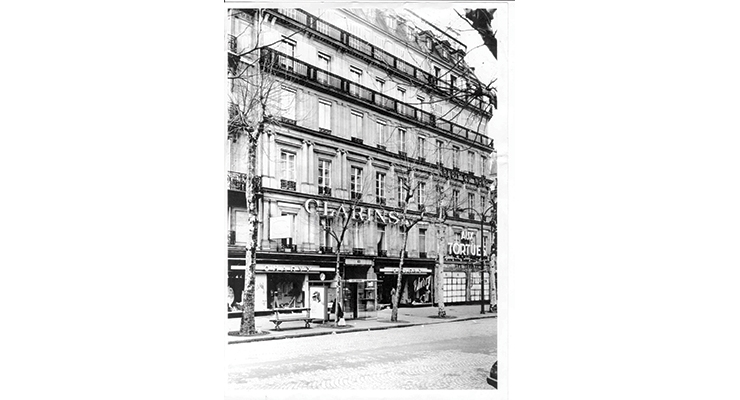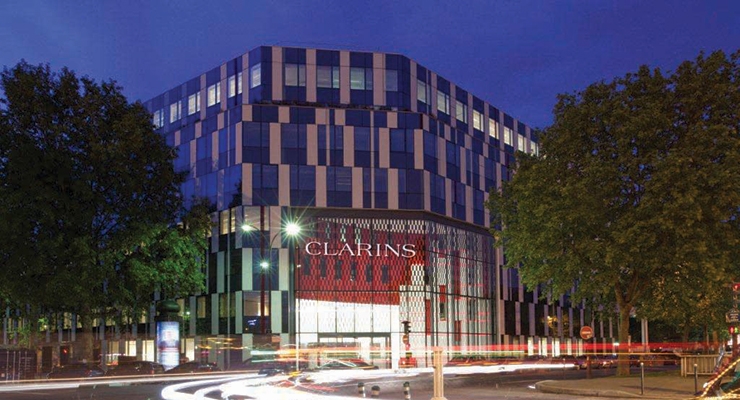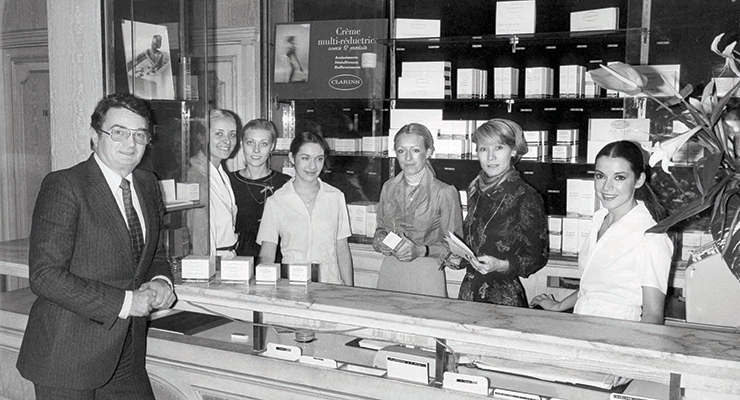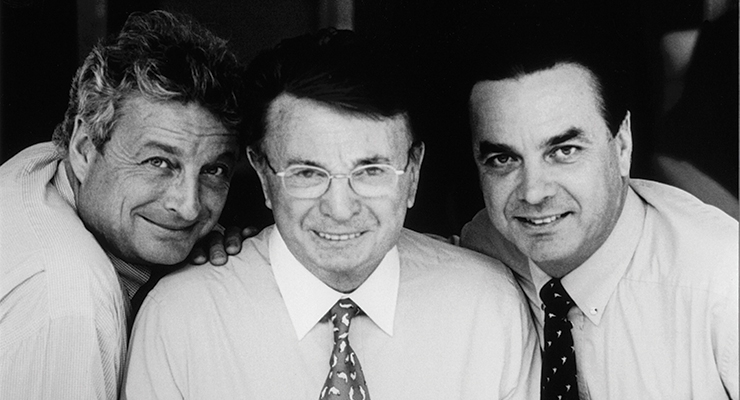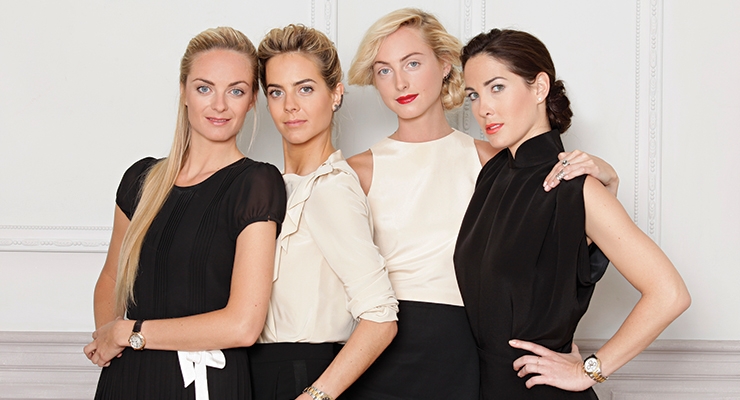Following is a look at the plant-science, consumer-centric based company—reportedly the No. 1 skin care brand in Europe—and some of its most popular products and standout packaging. The interview below, as well as our Online Exclusive with Danyelle Boilard-Paul, executive vice president and general manager for Clarins Groupe USA, are a fascinating insight into the brand—and its position as a prestige skin care, makeup and fragrance leader in the U.S.
Whereas our Indie Beauty Company of the Year, Stowaway, could be the star of a modern-day online marketing story, Clarins can be viewed almost like a fairy tale—but the two share some common approaches to beauty.
The History of Clarins & Its Name
Once upon a time, about 60 years ago, Clarins was founded on the basis of curiosity and compassion, when Jacques Courtin, a nine-year-old boy, overheard his sister and several of her friends complaining about what they believed to be their bodies’ shortcomings. Courtin’s interest in beauty was immediately piqued, and he set out on a mission to find solutions that would make women feel and look more attractive.
The young Courtin studied human anatomy and medicine—but his possible career as a doctor was thwarted by the war. Instead, his pursuit to beautify women led him to develop a weight-loss treatment institute, which specialized in massage as a way to eliminate cellulite and firm and tone skin. This, in turn, resulted in the introduction of cosmetic products that enhanced the treatments. In 1962, Clarins debuted its first packaged product for sale: Body Shaping Cream. It had been developed to streamline contours, shape, and eliminate cellulite.
The results-driven Courtin went on to introduce what he termed “air massage” treatments, used in combination with the market-changing pure plant oil products he had formulated. Courtin felt strongly that there was an answer for everything within the plant world.
He chose the name Clarins for his spas, creams and lotions, adopting it from a kindhearted role he had played in a school drama production. He later added it to his surname, as well.
Finding great success in clinics made Courtin-Clarins realize that women could benefit even more if they could apply the products at home daily, rather than weekly at a beauty center—which led to numerous lines for skin care regimens.
Moving Quickly Toward Success
The company grew quickly over the years, adding products and services that satisfied consumer demand, until the family-owned business became a European leader in Skin Care and Body Care. Always, Courtin-Clarins stressed the importance of the method of application in how effectively the formulation impacted and affected the skin.
In addition to being a progressive and insightful formulator and packager, Courtin-Clarins was a savvy marketer. The press responded with favorable reviews of Clarins products, and spread news of spa and at-home treatments—resulting in further expansion. Along the way, the company focused on training sales assistants, implementing a customer feedback program and distributing “beauty prescriptions” and “try-before-you-buy” samples.
By 1971, Clarins was sold in almost 15 countries. Subsidiaries started springing up from Europe to Asia. In 1980, Clarins became the leading luxury skin care brand in France. In 1981, it opened its first U.S. subsidiary.
Clarins’ success led to its going public in 1984. In the ’90s, Jacques’ son, Dr. Olivier Courtin-Clarins, an orthopedist, joined the company, alongside his brother Christian.
In 2008, following the 2007 death of their father, the Courtin-Clarins brothers made the decision to leave the stock market and privatize the family enterprise. Today, Clarins rules as a world leader in Beauty, and remains committed to a philosophy based on plant science, plant extracts, a pioneering spirit—and above all, listening and catering to women’s desires for healthy, beautiful skin and a glowing, accentuated visage. Overriding all is a corporate philosophy based on respect for both the consumer and the environment.
Clarins Today: Its Leadership & Brands
Zrihen
As Clarins is a privately held company, it does not publish its financials, but according to Women’s Wear Daily, the Group’s 2014 beauty sales reached an estimated $1.74 billion.
The Clarins Group, with labs in Paris, consists of face care, body care, sun care, makeup and men’s products, including the customized spa range, My Blend, as well as fragrance. The Clarins Fragrance Group includes Porsche Designs Parfums, David Yurman fragrances, and Swarovski parfums. It also owns the organic cosmetics brand Kibio, and is a stockholder in L’Occitane. Clarins also owns the Thierry Mugler fragrances brand, including Angel and Alien.
Today, Clarins boasts more than 1,500 employees, the majority of whom are women, and says its values continue to follow those laid out originally by Jacques Courtin-Clarins: respecting the client, and always “listening, listening, listening”—and “doing good by giving beauty,” which also encompasses giving back to nature and communities. A key tenet: “Never develop a product without adding a social or environmental element to it… this is the continuous progress pledge that all [Clarins] brands have adopted.”
Packaging with a Distinct DNA
Touches of red tie to the Clarins DNA.
Courtin-Clarins originally chose a red-and-white color scheme for his packaging, because he said he didn’t have much of a budget for optimizing placement in stores, and “Red really gets your attention.” He later added gold “for a touch of prestige.”
Today, the color range of the brand’s packaging has been broadened from the original red, in order to highlight and distinguish various product lines. Next month, Clarins will launch Day & Night products in pink and blue jars. (For more info, see interview with Danyelle Boilard-Paul.)
Viktorija Gnatoka, global packaging analyst, Mintel, says, “Clarins is distinct in its shapes and design—and most important, packaging features that consumers are looking for.”
Commenting on why Beauty Packaging’s readers may have selected Clarins as the “2015 Global Beauty Company of the Year: Excellence in Packaging,” Gnatoka says:
“I think the key features that stand out with Clarins packaging are novelty and consistency. On the one hand, Clarins features innovative shapes and designs, and adds packaging features that speak to specific packaging attributes important for consumers, such as being refillable. On the other hand, the company keeps consistency among each of its brands, making the packs easily recognizable on shelf. For example, the contoured star-shaped bottles of Thierry Mugler fragrances and the refill stations became a brand trademark that can be easily recognized among many other brands on shelf.” (Customers can purchase the sculptural bottles once, and then return to counter to refill the juice; the refill stations launched in 1992.)
Jacques Courtin-Clarins originally chose the color red “because red really gets your attention.” It’s still a popular shade for the brand.
Gnatoka points to customization. She says, “I think in keeping up with trends. Clarin’s brand My Blend is a great example of personalization in cosmetics and pretty much any other category where consumers are looking for personalized solutions.
According to Gnatoka, in the U.S. alone, 76% of U.S. anti-aging skin care product users are interested in products designed specifically for their life stage, and 10% of U.S. female consumers are looking to customize their fragrance, so they like that Thierry Mugler offers an ability to refill. “I think all of these features make Clarins packaging very relevant to what consumers are looking for,” says Gnatoka.
Sustainable Packaging Early On
Clarins takes pride in the fact that they determined many years ago to take an environmental approach to how their many formulations are packaged and how ingredients are sourced.
Clarin’s first carbon assessment, conducted in 2007 revealed that product packaging was the primary source of the Group’s greenhouse gas emissions. To lessen the effects, the brands reduced product weight and volume, chose recycled and recyclable materials, and raised awareness around reuse.
Gnatoka notes that Clarins’ eco-friendly efforts resonate with purchasers. She says, “An ability to refill the pack is viewed by consumers as a way to use the packaging again and this makes it more environmentally responsible.” According to Gnatoka, 48% of U.S. consumers associate glass packaging with reusable and repurpose-able, which can work great for many fragrance and skin care brands. “It also gives consumers an ability to contribute to the environment,” she says, adding, “A recyclable pack as such is no longer a desired attribute, but consumers’ expectation.”
Clarins Multi-Active Day & Night with Teasel: Pink and blue jars make differentiation easy in a brand new launch aimed at stressed-out Millennials.
When redesigning its skin care line, Clarins evaluated its 50ml jar from an environmental perspective and chose to use glass rather than plastic as, overall, glass was less impactful on the environment. It was improved upon so that it became 12% lighter in weight. In general, all Clarins glass jars are now made of 20% recycled glass.
Clarins notes that while “packaging updates might not be noticed by clients since they do not affect product use or enjoyment,” efforts to reduce the use of resources continue: “Superfluous packaging is no longer used to wedge small products, outer cartons are lighter, product information is printed on both sides of the outer carton, decoration is minimal, ballasts are no longer used in the makeup compacts, and new recycling programs have been set up in Clarins boutiques in France.”
In addition, facial cleansers were re-launched without outer cartons (a savings of 97 tons of cardboard), and the plastic coating on ClarinsMen outer cartons was eliminated, which saves four tons of plastic film per year.
The sculptural bottle for Angel by Thierry Mugler is refillable at counter.
Anti-pollution has been a benefit offered by Clarins since 1991.
This involves searching far and wide to find the best plants. And while some products have been popular for decades, the labs are always revising and perfecting formulas as technology advances.
Savvy Skin Care
Clarins launched its now-extensive product line with skin care, and has always prided itself on its ahead-of-the-curve development in providing preventative solutions for customers.
“The Clarins brand started with the development of professional skin care treatments,” explains Christian Courtin-Clarins, chairman of the supervisory board. “My father strongly believed in natural plant extracts. In 1954, he created face and body treatment oils for his clients based upon 100 percent pure plant extracts to rebalance the skin. The products still exist today. It’s one of the unique successes where a product range has existed for such a long time.”
The ClarinsMen range premiered in 2002.
The ultra-personalized My Blend range consists of an Essential Formula adapted to the age and specific features of the skin, to which a booster is added. This pure ingredient concentrate, designed to address immediate problems, allows skin care to adapt to the behavioral changes of the skin. The individual diagnosis is completed only at Spa My Blend by Clarins locations. A skin care program is then prepared, selected from 400 possible combinations, and a targeted treatment is provided.
Similar to its development of 100% based-plant formulas, Clarins may have also been ahead of the times in thinking about the role dispensing plays in elevating products’ efficacy. Jacques Courtin-Clarins lays claim to sparking the development of the first dual-dispenser for Clarins Double Serum, launched in 1985, and still the brand’s No. 1 product. It was his solution for merging ingredients that were soluble only in oil with others that were soluble only in water.
Clarins Double Serum features a dual-chamber system that combines two formulas into one, as well as an airless dispensing system that helps to preserve the ingredients. As technology has developed, the product and the package have been updated. The packaging prevents incompatibility as it mixes the precise amounts of each formula at the moment of use. Double-sided printing—so that the product insert is no longer needed—and lighter packaging components are eco-friendly features of the product’s outer carton.
Makeup Packages As ‘Elegant Objects’—and Eco-Friendly, Too
Courtin continued to refine his view on packaging from an aesthetics perspective as well as a functional one.
Anti-pollution—which Courtin described as the No. 2 factor in aging—was a key element of one of Clarins’ early makeup launches, in 1991. However, soon after this collection appeared on shelf, Jacques Courtin-Clarins recognized that the packaging had not quite reached his expectations. He said he had not realized just how important the container was to the consumer—more important than with skin care products. He explained, “A lipstick is a color. After that it’s an elegant object you should be proud to use in public. Then and only then, is it something that’s good for your lips.”
Packaging for cosmetics also took sustainability into the picture. Today, many of Clarins’ makeup items are developed without using ballasts, so compacts are light in weight, both for the hands and for the planet.
A Squeeze of Sunshine
According to Mintel, “struggles in the self-tanning segment are prompting companies to introduce new formats that address some of the ease-of-use and natural-looking color issues that plague the category. One extension of this trend has been the launch of boosters that can be added to lotions, allowing users to customize their level of color.
Clarins Radiance-Plus Golden Glow Booster is a made-to-measure self-tanning product designed to create an even, radiant glow in a single daily step, providing a tan that develops evenly on the skin and looks natural. Quick and easy to use, the consumer needs only to squeeze three drops into a favorite moisturizer or foundation—and spread on skin. The Booster is available for both face and body.
Once again, Clarins listened, heard its customers’ need and solved the problem in a way that made them feel beautifully tanned and healthy—with an innovative dropper package, to boot.
Looking Ahead
What can we predict from Clarins going forward—in terms of packaging? Gnatoka speculates that the French beauty conglomerate will perhaps expand its portfolio and add more packaging that is in line with consumer trends such as personalization and interactive packaging—making consumers happy ever after.
An Interview with Clarins' Danyelle Boilard-Paul, Part One
Next an interview with Danyelle Boilard-Paul, executive vice president and general manager for Clarins Groupe USA. (This interview continues in our Online Exclusive: The Story Behind Thierry Mugler Fragrances).
Danyelle Boilard-Paul
Following a successful career that started in 1985 with The Estée Lauder Companies, Danyelle Boilard-Paul joined the Clarins family enterprise in 2002 as vice president for the Clarins Fragrance Groupe division in Canada, and went on to grow that category—and skin care—in the U.S. In 2013 she was appointed Executive Vice President and General Manager for Clarins Groupe USA, putting her at the helm of one of the largest subsidiaries for the brand worldwide. She is now concentrating her efforts on expanding and strengthening the brand’s position as a prestige skin care, makeup and fragrance leader in the U.S.
JM: How has Clarins evolved and what are your goals for the brand?
DBP: Since its founding in 1954, the Clarins DNA hasn’t changed—to work closely with the women that we service, to listen to them, to care for them. Our mission has always been to provide each and every woman with the best and most effective products for her beauty concerns. Any time we develop or perfect a product, it comes from feedback from them. We want to be the most consumer-centric brand in the U.S., truly focusing on the customer, providing her with the best online and offline experience, via clarins.com and our department store distribution.
JM: What is Clarins’ forté?
DBP: Respect. Respect for our customers—by doing more, better and in a sustainable way. Respect for nature—by protecting biodiversity, preserving natural environments and rural developments. Respect for the environment—by creating formulas that are safer, and designing products, packaging and communication tools with the lowest environmental impact possible. Respect for our vendors and retailers. Respect for everyone that we touch. This is a major value of the family and the company as a whole.
JM: Who is your target customer?
DBP: We don’t have a specific target customer. Our philosophy at Clarins is to provide the consumer with products for the different stages of her life. In the skin care category for example, our Multi-Active range is meant for millennial women in their late 20’s and early 30’s who live a hectic life and are experiencing their first fine lines and loss of skin radiance. The next range, Extra-Firming, is for women in their late 30’s and early 40’s who are more concerned with skin firmness and wrinkles. And the Super Restorative range is for women experiencing deep wrinkles, age spots and skin slackening. All of the products within these ranges were specifically created with the consumer in mind, providing her with straightforward solutions for her beauty concerns.
JM: What is the general brand message?
DBP: Consumer-centricity. We are all about the consumer. Anything we do, whether creating a brand new product or perfecting an existing product via customer feedback, we do it for the consumer—to service her, to fulfill her beauty needs, to make her skin look and feel better, to provide her with the best experience. It’s all about her.
JM: What in particular made Clarins stand out packaging-wise in 2015?
DBP: Clarins’ Total Eye Concentrate, Super Restorative Remodelling Serum and Mission Perfection Serum have an airless double-wall packaging, specifically developed for Clarins. The airless packaging allows for a very safe formula and is ideal to release the product until the very end, whatever the texture. The pump also allows for a precise product dosage. The Clarins brand also pays particular attention to the finishing touches in order to have a design as attractive and as modern as possible to answer our consumers’ expectations. It is also important to differentiate one range from another, using for example, red and gold for a line addressing the skin concerns of mature women, and silver and coral for a line addressing dark spot correcting.
The packaging for Golden Glow Booster for Body was first introduced in the Clarins catalog in 2014 when the face version was launched. The pack is an integral part of the product concept as this dropper allows for a very precise product delivery, releasing an exact number of drops of the self-tanning formula, therefore allowing for a made-to-measure dosage and the perfect solution to each consumer’s needs. The amber color of the packaging is also coherent with the codes of the self-tanning range of Clarins.
JM: How many products were introduced in 2015?
DBP: 12 Total: 4 Skin Care, 4 Makeup, 1 Body, 1 Sun, 2 Men
In the Spring of 2015, we launched Total Eye Concentrate, UV Plus Anti-Pollution Broad Spectrum SPF50, Everlasting Foundation+ SPF15, Instant Light Lip Balm Perfectors, Instant Light Lip Comfort Oils, and Body Shaping Cream.
In the Fall of 2015, we launched Mission Perfection Serum, Super Restorative Remodelling Serum, Golden Glow Booster for Body, Joli Rouge Lipsticks, ClarinsMen Revitalizing Gel, and ClarinsMen Anti-Fatigue Eye Serum.
JM: Which product in 2015 had the most outstanding—or innovative—package?
DBP: The packaging behind Double Serum is certainly the most complex and innovative that Clarins has ever developed. The packaging team was challenged to develop a bottle that was perfectly compliant with this unique double formula: a double pump system for an ultra-precise dosage of the two formula phases. Indeed, to preserve the intact power of the water- and oil-soluble ingredients, Double Serum’s two phases are never in contact with one another. Each vial has a separate pump dispenser, ensuring the two formulas are mixed only upon application and always in an ideally balanced ratio.
JM: How does the Clarins Design/Product Development team approach the packaging of a new product?
DBP: From a responsible development angle, the packaging development teams have updated the eco-calculator (started in 2010) that guides all Marketing and Purchasing teams with clear environment criteria. This is an ongoing process aimed at fulfilling one of the responsible development commitments of the Clarins Group, which is to produce with as low an environmental impact as possible.
Packaging at Clarins is always developed with the objective to serve the formula and our consumers. Each packaging meets these criteria of high quality:
- Perfect compatibility with the formula
- Usage of the product until the very end
- Practical and intuitive daily usage
- Packaging with pure and contemporary lines
- Qualitative materials
- Finishing touches and colors in coherence with the prestige skin care image of the brand
- Products that are pleasant to use for the consumers
- Eco conception: choice of recyclable materials and of partly or entirely recycled materials (for example, our 50ml glass jars), choice of paper issued from responsibly managed forests for our outer packaging, choice of 100% recycled paper for our product leaflets. In general, all Clarins glass jars are made of 20% recycled glass.
JM: Are there any overall criteria that Clarins packages meet?
DBP: Clarins packaging contains 63% recyclable materials (glass, cardboard, paper). The end objective is to reach 100%. All our paper and cardboard supplies are issued from responsibly managed forests—with FSC or PEFC certificates. During 2015, the brand established strict responsible criteria in the selection of its paper-cardboard suppliers.
A beauty brand like Clarins cannot be global without being responsible and taking care of humanity. Since its creation, the fundamental values of the brand remain unchanged: respect of people (consumers, collaborators, and suppliers), respect of nature (the source of our wealth).
In 2010, Clarins carried out a major renovation of its packaging design across 100% of its catalog. Numerous designs were exclusively created for Clarins, with a new oval signature, neat round caps bearing the Clarins logo for more modernity, finishing touches in gold for the anti-aging franchises, color codes on the outer packaging to better guide the consumers within the different categories. This new design represented a major change in the Clarins packaging identity, making it more contemporary, while still respecting the environment.
JM: Is there a particular direction in which the brand is going?
DBP: For many consumers, what they know of Clarins are facial skin care products. But we are a beauty brand, and our products range from face care, body care, sun care to makeup. So at the same time as we want to grow our skin care market share in 2016, our goal will be to make our consumers discover our incredible makeup products—for lips, cheeks, foundations and eyes—which are formulated with plant-based ingredients that have the same skin care benefits as our facial skin care products, delivering your ideal makeup look while protecting and correcting your skin.
JM: Describe several things about Clarins and its packaging that Beauty Packaging’s readers may be unfamiliar with.
DBP: Our less is more philosophy. One of our top priorities is adopting a responsible attitude toward the manufacturing process for our products, being effective but sustainable with the essentials. We don’t over package. Instead, we believe it is of utmost importance to optimize our use of natural resources and minimize their environmental impact. In recent years, Clarins has implemented numerous initiatives that aim to respect and protect nature—such as creating new recyclable packaging, reducing the weight and volume of materials we use, limiting unnecessary production and reducing greenhouse gas emissions. Our packaging truly reflects who we are as a brand, not only through our strong concern for sustainability, but also through our design process. For example, each facial skin care range is labeled with a different color—Super Restorative is red, Extra-Firming is gold, Multi-Active is pink—which ultimately facilitates the customer’s purchases. Our packaging is simple yet effective.
JM: What is the role of samples in Clarins’ marketing program?
DBP: Samples are a very important aspect of our program. We want each and every customer to have the best purchasing experience possible. At counter level and online, our beauty representatives are trained in a very strict way on how to sample products. Our goal is for the customers to try before they buy so we can determine, together, which products are best for her skin care or makeup concerns.
JM: Is the brand predominantly a department store brand? How else does Clarins reach out to consumers?
DBP: Yes, we are predominantly a department store brand. In the U.S., we made the decision to maintain a somewhat small distribution compared to our competition. But we are in the major key department store chains in the U.S., including Nordstrom, Bloomingdale’s, Macy’s and Sephora.
At counter level, we connect with consumers through our skilled beauty advisors who offer personalized consultations.
Online, we connect with consumers via our social media platforms (@ClarinsNews on Instagram, Twitter and Facebook) and email. We have also implemented a “Turn To” program, which allows women to ask questions about products to consumers who’ve already used them and receive true feedback on what impacts these have had on their skin. And this philosophy of ‘listening to women’ goes back to 1954, when our founder Jacques Courtin-Clarins implemented feedback cards into all of his products. He read each and every one of these cards, and through them, he learned what beauty concerns women had and what products he needed to create for their needs. Sixty years later, we are still listening to women.
JM: What will Clarins’ focus be in the years ahead?
JM: Where does the bulk of company sales lie in the U.S.?
DBP: We have a strong penetration in the Boston, Chicago and Miami markets, where our brand has definitely been resonating with the local consumers. We have also had several success stories in the New York City area as well. In terms of product, our serum and moisturizer are the two categories that have been resonating in a meaningful way with U.S. consumers.
JM: What is the secret behind Clarins’ success?
DBP: The secret is that we have modernized the brand as technology has advanced, but always keeping in mind our principles that were established in 1954. It is of utmost importance to never lose touch with the beginnings. Although we are a very modern brand, we have stayed true to the DNA of the brand, to what our founder Jacques Courtin-Clarins created that was so dear to his heart—and that is, the consumer.
JM: Where do you see the Clarins brand five years down the road?
DBP: In a global sense, I see the brand continuing to develop strong face, body, and makeup products to answer every single need of the consumer. And in the U.S., our goal is to further create awareness and visibility, and to recruit new customers in key markets such as Los Angeles, San Francisco, New York, Chicago, Miami and Boston.

